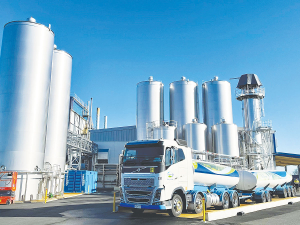Fonterra slashes forecast milk price, again
Fonterra has slashed another 50c off its milk price forecast as global milk flows shows no sign of easing.
 Fonterra's plan to divest businesses in Sri Lanka, Australia and New Zealand means its position as the sixth ranked dairy processor in the world may be short lived.
Fonterra's plan to divest businesses in Sri Lanka, Australia and New Zealand means its position as the sixth ranked dairy processor in the world may be short lived.
Fonterra has climbed three places to number six on RaboResearch's annual Global Dairy Top 20 report.
However, the co-operative's plan to divest businesses in Sri Lanka, Australia and New Zealand means its position as the sixth ranked dairy processor in the world may be short lived.
Fonterra sits behind Lactalis, Nestlé, Dairy Farmers of America, Danone and Yili on the list.
Lactalis, with revenues of US$30 billion retains the top spot. European co-ops Arla Foods and FrieslandCampina sit seventh and eighth respectively.
The report says Fonterra's revenue jumped, lifting the cooperative's ranking three places over last year. While acknowledging performance was strong, the report notes that Fonterra's financial year-end was July 31, 2023, meaning higher revenues likely reflect elevated commodity prices throughout the second half of 2022, which may have skewed the comparison to key global competitors with different financial year-end dates.
The report says Fonterra is unlikely to maintain sixth position in coming years given the cooperative's strategic shift to focus on its core business and the potential for this to reduce future revenues.
"Fonterra announced 'a step change in its strategic direction' to be achieved via a pivot back to its core B2B ingredients and foodservice business," the report says.
"If all the considered divestments come to fruition, this could represent 15% of the co-op's milksolids utilisation and 19% of the group's earnings, representing a sale valued at more than NZ$2 billion."
The report also notes a year of modest gains and strategic shifts within the dairy sector.
The report, which analyses the financial performance of the world's leading dairy companies, indicates a slight 0.3% increase in combined turnover in US dollar terms, a stark contrast to the previous year's 8.1% growth.
Fewer than half the companies listed maintained the same position as last year. Foreign exchange developments continue to impact the overall rankings, and limited mergers and acquisitions activity was again a key theme this year.
The report attributes the deceleration in revenue growth to lower milk prices in 2023 compared to the robust values seen in 2022. This trend particularly affected European cooperatives, and seven companies worldwide reported lower revenues in their local currencies. Despite this, many companies have managed to report stronger profits and margins than in the previous year.
France's Lactalis became the first company ever to exceed US$30bn in annual dairy-related revenue, an accomplishment that follows several years of significant revenue expansion through organic growth and acquisitions.
The Push-Up Challenge, an event which combines mental health and fitness, is set to launch in New Zealand in 2026.
Last month's Agritechnica event led to a wide group of manufacturers celebrating successes when the 2026 Tractor of the Year Competition winners, selected by a panel of European journalists, were announced in Hanover Germany.
According to the latest Federated Farmers banking survey, farmers are more satisfied with their bank and less under pressure, however, the sector is well short of confidence levels seen last decade.
Farmer confidence has taken a slight dip according to the final Rabobank rural confidence survey for the year.
Former Agriculture Minister and Otaki farmer Nathan Guy has been appointed New Zealand’s Special Agricultural Trade Envoy (SATE).
Alliance Group has commissioned a new heat pump system at its Mataura processing plant in Southland.
President Donald Trump’s decision to impose tariffs on imports into the US is doing good things for global trade, according…
Seen a giant cheese roll rolling along Southland’s roads?